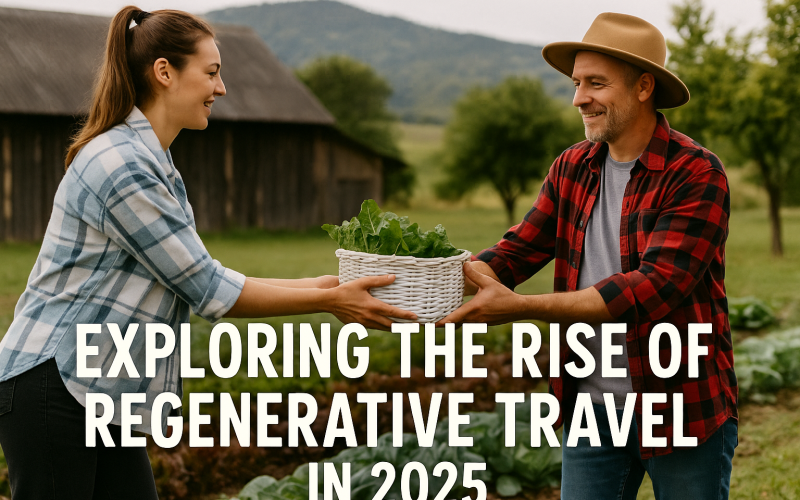Introduction
In 2025, travel is changing. More people are choosing to travel in a way that helps protect the environment and supports local communities. This new way of travel is called regenerative travel. Unlike regular tourism, where we just try to reduce harm, regenerative travel focuses on actually improving the places we visit.
In this guide, we will explain what regenerative travel is, why it is important, and how you can practice it. Let’s explore how regenerative travel can make your trips not only fun but also good for the planet and its people.
What is Regenerative Travel?
Regenerative travel is about making travel better for the environment, the people, and the culture of the places we visit. Instead of just trying to make travel less harmful, regenerative travel aims to leave a positive impact. This means helping nature recover, supporting local businesses, and respecting the culture of the places we visit.
In simple terms, when you travel with Regenerative Travel, you are doing something good for the world, rather than just taking from it.
Why Is Regenerative Travel Important?

Travel can have a big impact on the places we visit. In many cases, tourism can harm the environment, cause pollution, or hurt local cultures. That’s why regenerative travel is so important. Here are some reasons why it matters:
Environmental Restoration and Conservation
Regenerative travel focuses on activities that help heal and improve the environment, not just protect it. This can include things like planting trees, cleaning up beaches, or supporting wildlife conservation projects. Many travel companies now offer trips where travelers can help out with local environmental efforts, such as cleaning coral reefs or supporting wildlife reserves.
For example, some eco-friendly resorts and lodges now work on a regenerative tourism model. This means they help restore the land they use by investing in renewable energy, saving water, and using organic farming methods.
Supporting Local Communities
One important part of regenerative travel is helping local communities. Instead of spending money at big international hotel chains, regenerative travelers often choose to support locally owned businesses. This might mean staying at small guesthouses, eating at family-run restaurants, or buying handmade goods from local artists.
When travelers support these local businesses, they help strengthen the economy and keep money in the area. This also helps preserve the local culture and traditions.
Cultural Preservation and Education
Regenerative travel also focuses on preserving local cultures. It encourages travelers to respect and learn from the people they meet. This can include joining in local traditions, buying local crafts, or learning about the region’s history and customs.
By taking the time to understand and appreciate local cultures, travelers can help protect them for future generations. This creates respect and understanding between tourists and locals, building stronger connections and ensuring traditions are not lost in a fast-changing world.
How to Travel the Regenerative Way

If you want to try regenerative travel, here are some simple steps you can take to make a difference:
Choose Eco-Friendly Accommodations
When you travel, choose places to stay that care about the environment. Look for hotels, hostels, or guesthouses that use green practices, such as reducing waste, using renewable energy, or supporting local projects. Many eco-friendly places also help the local community by hiring local staff and buying supplies locally.
Support Local Businesses
Instead of spending money on big companies or chains, spend it on small, local businesses. This can be a local restaurant, a handmade craft shop, or a tour run by local guides. Your money will go directly to the community, helping them thrive.
Get Involved in Local Projects
Many destinations offer opportunities for tourists to get involved in community or environmental projects. You might help clean up a beach, plant trees, or work with a local school. Volunteering during your trip is a great way to give back to the place you are visiting.
Respect Nature and Culture
When you travel, always be mindful of the environment and the local culture. Don’t disturb wildlife, leave trash behind, or disrespect traditions. Learn about the place you are visiting and treat it with care and respect. Simple actions, like staying on marked trails or supporting cultural festivals, can help preserve what makes each place special.
Offset Your Carbon Emissions
Traveling by plane or car can produce carbon emissions that contribute to climate change. Consider offsetting your emissions by donating to projects that reduce carbon or support clean energy. Some airlines and travel companies offer this option when you book your flights.
The Future of Regenerative Travel

As more people learn about regenerative travel, it’s likely that the tourism industry will keep growing in this direction. More hotels, restaurants, and tour companies will adopt regenerative practices, making it easier for travelers to make a positive impact. Governments and organizations are also starting to support regenerative tourism by creating policies that protect the environment and local cultures.
In 2025, regenerative travel will continue to shape how we travel, making it a more responsible and rewarding way to explore the world.
Table: Regenerative Travel Planning Checklist
| Step | Action | Example Tool/Resource |
|---|---|---|
| Research Certifications | Look for Green Globe, B Corp, Ecotourism Australia | Certification directories online |
| Eco‑Friendly Stay | Choose lodges with solar, water treatment | Eco‑lodge booking platforms |
| Ethical Excursions | Book tours with local guides and impact reports | Local tourism boards |
| Responsible Packing | Use refillable, biodegradable items | Reusable bottle, eco toiletries |
| Volunteer Opportunities | Extend stay to join reforestation or reef work | Local NGOs, conservation groups |
Conclusion
Regenerative travel in 2025 is about making a positive impact wherever you go. By supporting local communities, respecting cultures, and protecting the environment, you can help ensure that future generations will also be able to enjoy the beauty of the world. It’s not just about what you can take from a destination, but also about what you can give back.
Traveling the regenerative way allows you to enjoy new experiences while making the world a better place. It’s time to start thinking about how your travels can contribute to a more sustainable and fair world.
Call-to-Action (CTA)
Ready to travel with purpose? Start planning your next regenerative Travel Experience today! Explore eco-friendly accommodations, support local businesses, and take part in projects that help the environment. Visit our website to find more tips and resources on how to travel responsibly in 2025.












